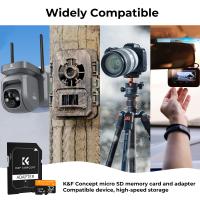How To Read Sd Memory Card?
Reading an SD memory card is a common task that many people need to perform, whether for transferring photos from a camera, accessing files on a mobile device, or retrieving data from a digital recorder. This article will guide you through the various methods and tools available for reading an SD memory card, addressing common issues and providing practical solutions.
Understanding SD Memory Cards

Before diving into the methods of reading an SD memory card, it's essential to understand the different types of SD cards available. SD cards come in various sizes and capacities, including:
1. Standard SD Cards: These are the original SD cards, typically up to 2GB in capacity.
2. SDHC (Secure Digital High Capacity): These cards range from 2GB to 32GB.
3. SDXC (Secure Digital Extended Capacity): These cards offer capacities from 32GB to 2TB.
4. MicroSD Cards: These are smaller versions of SD cards, commonly used in smartphones and other compact devices. They also come in SDHC and SDXC variants.
Methods to Read an SD Memory Card

1. Using a Built-in SD Card Slot

Many laptops and some desktop computers come with built-in SD card slots. This is the simplest method to read an SD card:
1. Insert the SD Card: Gently insert the SD card into the slot. Ensure it is oriented correctly to avoid damage.
2. Access the Card: Open your file explorer (Windows) or Finder (Mac) to access the SD card. It should appear as a removable drive.
3. Transfer Files: You can now copy, move, or delete files as needed.
2. Using an External SD Card Reader

If your computer does not have a built-in SD card slot, you can use an external SD card reader. These devices connect via USB and are relatively inexpensive.
1. Connect the Reader: Plug the SD card reader into an available USB port on your computer.
2. Insert the SD Card: Place the SD card into the reader.
3. Access the Card: Open your file explorer or Finder to access the SD card.
3. Using a Mobile Device
Many smartphones and tablets can read SD cards, especially if they have a dedicated slot or support OTG (On-The-Go) adapters.
1. Insert the SD Card: If your device has an SD card slot, insert the card. For devices without a slot, use an OTG adapter and an external card reader.
2. Access the Card: Use your device's file manager app to access the SD card. You may need to download a third-party app if your device does not have a built-in file manager.
4. Using a Camera or Other Device
If your SD card is primarily used in a camera or another device, you can often connect the device directly to your computer.
1. Connect the Device: Use the appropriate cable to connect your camera or device to your computer.
2. Access the Card: The device should appear as a removable drive in your file explorer or Finder. You can then access the SD card's contents.
Troubleshooting Common Issues
1. SD Card Not Recognized
If your SD card is not recognized by your computer or device, try the following steps:
1. Check the Connection: Ensure the SD card is properly inserted and the card reader is securely connected.
2. Try a Different Port: If using an external reader, try a different USB port.
3. Test on Another Device: Insert the SD card into another computer or device to see if it is recognized.
4. Update Drivers: Ensure your computer's drivers are up to date. You can check for updates through your operating system's settings.
2. Corrupted SD Card
If your SD card is corrupted, you may still be able to recover your data:
1. Use Disk Utility (Mac): Open Disk Utility and select the SD card. Click "First Aid" to attempt a repair.
2. Use CHKDSK (Windows): Open Command Prompt and type `chkdsk [drive letter]: /f` to check and fix errors.
3. Data Recovery Software: If the above methods fail, consider using data recovery software like Recuva or Disk Drill.
3. Write Protection
Some SD cards have a physical write-protection switch. If you cannot write to the card, check the switch:
1. Locate the Switch: On the side of the SD card, there is a small switch.
2. Disable Write Protection: Slide the switch to the "unlocked" position.
Best Practices for SD Card Usage
To ensure the longevity and reliability of your SD card, follow these best practices:
1. Safely Eject: Always safely eject your SD card before removing it from your computer or device to prevent data corruption.
2. Regular Backups: Regularly back up the data on your SD card to another storage medium.
3. Avoid Physical Damage: Handle your SD card with care to avoid physical damage.
4. Format Periodically: Periodically format your SD card to maintain its performance. Ensure you back up your data before formatting.
Reading an SD memory card is a straightforward process, whether you are using a built-in slot, an external reader, a mobile device, or a camera. By understanding the different types of SD cards and following the methods outlined in this article, you can easily access and manage your data. Additionally, by troubleshooting common issues and adhering to best practices, you can ensure the longevity and reliability of your SD card. Whether you are a professional photographer, a tech enthusiast, or a casual user, these tips will help you make the most of your SD memory card.











There are no comments for this blog.